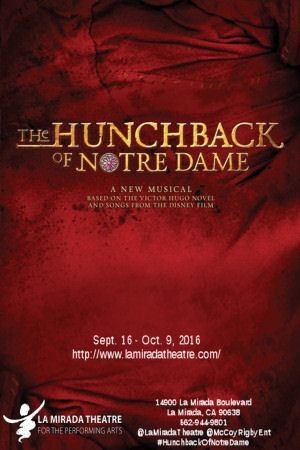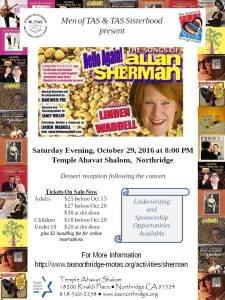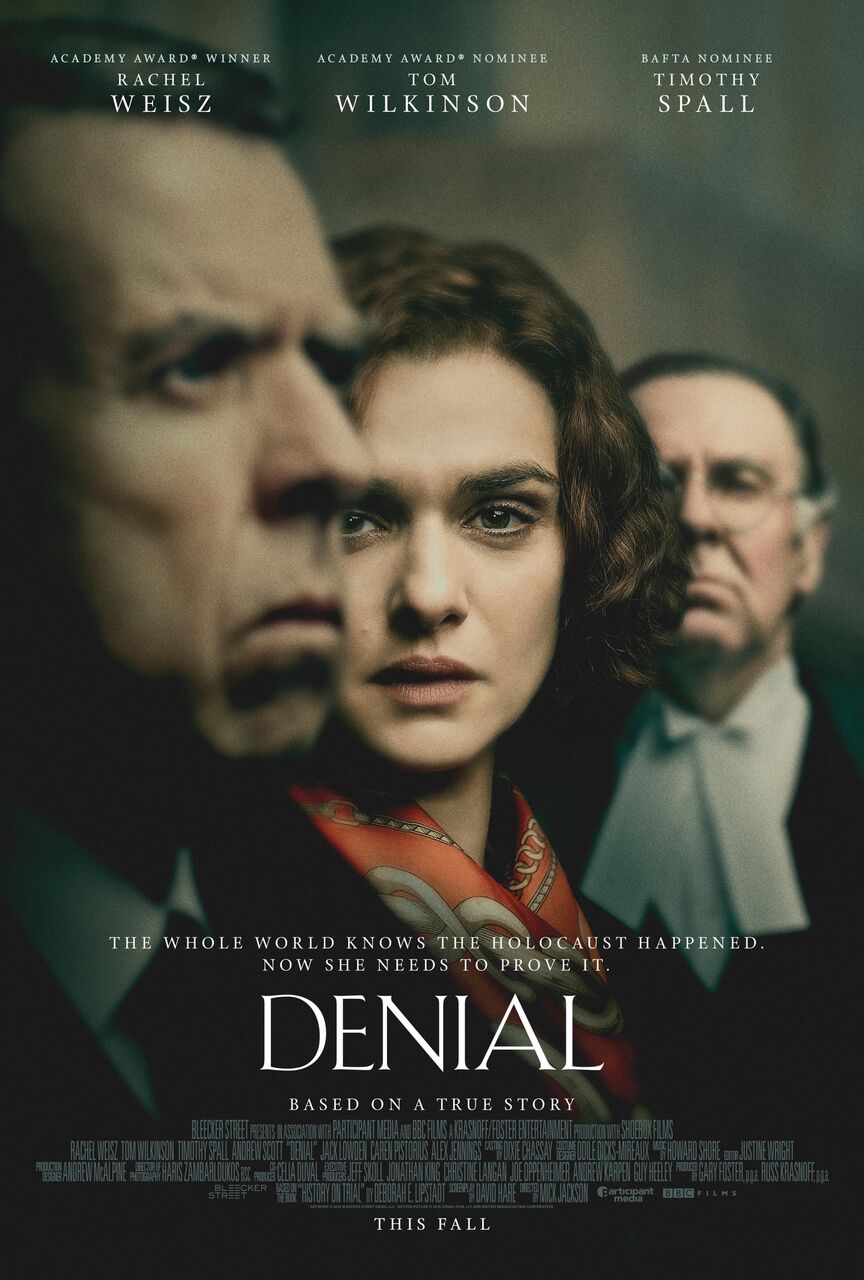
 When you attend theatre, there are shows that transcend the good or the great to become exceptional — shows that have elements that leave you astonished at the quality of the theatre arts — that are the perfect melding of acting and creativity and words and music and that special sauce that become indelible in your memory. Last night’s The Hunchback of Notre Dame at the The La Mirada Theatre for the Performing Arts (FB), based on the Victor Hugo novel and the songs from the Disney Film, was one of those shows. This is a show you must see in this incarnation, for I have no idea if it will be done in this particular way again.
When you attend theatre, there are shows that transcend the good or the great to become exceptional — shows that have elements that leave you astonished at the quality of the theatre arts — that are the perfect melding of acting and creativity and words and music and that special sauce that become indelible in your memory. Last night’s The Hunchback of Notre Dame at the The La Mirada Theatre for the Performing Arts (FB), based on the Victor Hugo novel and the songs from the Disney Film, was one of those shows. This is a show you must see in this incarnation, for I have no idea if it will be done in this particular way again.
Coming into the show, the first thing I would say is: drop your expectations. This is not exactly the Victor Hugo novel. It is definitely not the Disney film, although it retains the songs by Stephen Schwartz and Alan Menken. It retains some notions of the Disney adapation, although all cutesy humor has been dropped, along with the happy ending (it roughly retains the ending of the original). It is not the 1999 German musical version with a book by James Lapine — there are significant changes in the story there. It is based on the 2014 production at the La Jolla playhouse and the 2015 Paper Mill Playhouse version of the show (with a revised book by Peter Parnell) but even then there are some changes from that version. The seeds of this particular production were sown at the Sacramento Music Circus earlier in August 2016, and many of the cast members from that production are in this production.
Given the complexity of the story, I’m going to refer you to the Wikipedia entry on the Paper Mill Production for the detailed synopsis. The story focuses on the Frollo brothers, Claude and Jehan, and their legacy. Given salvation in the Cathedral of Notre Dame as infants, they are raised in the church. Jehen rebels and marries a Gypsy woman; Claude continues in the church and rises to Archdeacon, ever resenting the Gypsys for stealing his brother from him. On his deathbed, Jehan summons Claude and presents him with Jehan’s son, a deformed infant. Claude raises the boy, whom he has named Quasimodo, in the church, keeping him away from everyone in the bell tower (where he goes deaf from ringing bells). Quasimodo’s only friends are the stone gargoyles, who come to life and speak to him in his imagination. Once a year, the Gypsies are allowed to dance in the street; Quasimodo goes out that day and is crowned King of the Gypsies, and then taunted for his looks. The palace guards stop the taunting, and a gypsy woman, Esmerelda, comforts Quasimodo. She visits the church to see him, where Claude develops a lustful attraction for her. So does the captain of the guards. You can see the tragedy set in motion from that point, so I’ll leave it there. Suffice it to say that this doesn’t end well for everyone in the end (do Hugo’s novels ever do?).
What makes this production extra special is a conceit from director Glenn Casale (FB). Noting that the description of the story indicates that Quasimodo has gone deaf from ringing the bellw, he cast a deaf actor (John McGinty (FB)) as Quasimodo. Taking a que from the Deaf West Theatre Company (FB), he cast a different actor, Dino Nicandros (FB), as Quasimodo’s singing voice. He then incorporated ASL (American Sign Language) into the production: the gargoyles sign to Quasimodo as they sing with him; and McGinty signs as Nicandros sings. Note that I said that Nicandros is Quasimodo’s singing voice. When Quasimodo speaks to anyone else, it is McGinty (who is clearly deaf from his voice) speaking. This includes dialogue with both Frodo and Esmerelda. Essentially, the songs are a manifestation of Quasimodo’s thoughts, where in his head he can speak and be normal. The addition of the ASL brings that extra oomph, that extra poetry to the production, that extra magic. I truly hope that the Ovation voters see this show — McGinty is clearly deserving for this remarkable performance (and the emotion that Nicandros brings to the singing is truly special).
Also notable is McGinty’s transition. When the adult Quasimodo is introduced in the story, McGinty walks onstage as the handsome, non-deformed young man that he is. His singing voice hands him his outfit, and has he puts it on he transforms his hair, face, and posture to become the deformed Quasimodo. At the end of the show, the opposite transition occurs: McGinty removes his coat, straightens up, and becomes the handsome young man again. This reinforces the central question of this show: What makes a man a monster? Is it their looks, or their behavior? Who is the monster in the Hunchback of Notre Dame? [I’ll note that this is a very similar question to the one raised in Schwartz’s hit musical Wicked — are people born wicked, or do they become that way? Apply that same question here: Whoever you conclude was the monster — were they born that way, or did they become that way?]
But there are other performances that are spot on as well; this is not just a one-hunchback show. Particularly notable is the performance of Mark Jacoby as Dom Claude Frollo. The intensity that this man brings to this role is remarkable, especially in songs such as “Hellfire”. The character itself brought to me echos of Donald Trump in his reactions to immigrants, his anger, and his desire to keep the world safe and simple as he knows it. That echo is not intentional in the story, of course, but does make this story truly relevant to this year when we consider what makes a candidate human or a monster — the question of compassion vs. anger. But I disgress into the political; however, that’s what a great performance and great theatre can do. It can start you thinking, and finding the relevance of the classic stories to life today. By creating that echo in his performance, Jacoby adds to the exceptionalism of this production. He does what great acting does: transforms the act of an actor playing a character to an actor inhabiting and channeling the character, bringing a creation on the page to life on the stage. The leads here do that: McGinty/Nicandros and Jacoby certainly do.
The catalyst in this story, Esmerelda, is portrayed by Cassie Simone (FB). Unlike the other gypsies in the show who tend to be painted with a broad brush, Simone’s Esmerelda is deeper. Of course, she exhibits sexuality but not by the mere exposure of skin (in fact, the costuming of this production tends to keep the female gypsies relatively covered up). Her sexuality comes across in style, in movement, in dance, in attitude and in looks. In particular, what I think makes Simone’s Esmerelda particular attractive is she is not like the other gypsy woman: she has a mind of her own and an attitude of her own and she won’t let anyone tell her or force her to do something that she doesn’t want to do. That’s particularly sexy in a woman, although many woman fail to realize that. Simone has figured a way to bring that to her part through performance, again transcending the words on the page to inhabit a character on the stage. Remarkable singing, remarkable dancing, remarkable performance.
One other named performance is particularly worthy of note: Eric Kunze (FB) as Capt. Phoebus De Martin — the other man who is interested in Esmerelda, the man who is more interested in pleasure than policing, the man who gives up position to protect Esmerelda. Kunze gave a very handsome performance — by that I mean he upheld the tradition of some of his past roles, being the man who does the right thing and wins the girl (although that doesn’t quite happen here — remember, I said this was darker than the Disney musical). Kunze had a great singing voice and brought a good presence to the role.
The remaining named non-ensemble role was Keith A. Bearden (FB) as Clopin Trouillefou, the leader of the gypsies. He brought an interesting evil intensity to the role; there was something deeper in that role that was hinted at but not explored in the story. The other performance roles involved the ensemble, either in smaller named roles or as members of the congregation, as various gypsies, as the gargoyles and statues that talk to Quasimodo, and as townspeople, guards, and such. The talented ensemblists [named roles and positions noted] were Darian Archie (FB); Brandon Burks (FB); Doug Carfrae (FB) [Father Dupin (he is also Western Regional VP of Actors Equity], Cherrie Badajos Cruz (FB); Emily Dauwalder (FB); Rachel Farr (FB); Lance Galgon (FB) [King Louis XI]; Hannah Madeline Goodman (FB); Devon Hadsell (FB) [Florika, Dance Captain]; William Martinez (FB) [Lieutenant Frederic Charlus, ASL Captain]; Kevin McMahon (FB) [Saint Aphrodisus]; Shanon Mari Mills (FB) [Madame]; Dino Nicandros (FB) [Voice of Quasimodo]; Shannon Stoeke (FB) [Jehan Frollo, Fight Captain]; Stephanie Thiessen (FB); and Paul Zelhart/FB. I was particularly happy to see Devon Hadsell (FB) again — we still remember her performance in Lysistrata Jones; Shanon Mari Mills (FB), who we saw at Cabrillo; Rachel Farr (FB), who we saw in Carrie; and Shannon Stoeke (FB), who we saw at the Pasadena Playhouse.
This production was unusual in that it featured an on-stage non-acting choir — almost a church choir — that amplified the songs both in intensity and sound. The choir was under the management of Sean Gabel (FB), and consisted of Christopher M. Allport (FB), Stephen Amundson/FB, Brandon Banda/FB, Amy Lynne Bandy/FB, Emma Bradley/FB, Jennifer Cannon/FB, Emily Columbier/FB, Eric M. Davis/FB, Kimberly Fedderoff/FB, Nicolette Gamboa (FB), Kevin Gasio (FB), Kelsey Hamann/FB, Wendy Hinkle/FB, Grant Hodges/FB, Claire Marshall, Joey Nestra (FB), Madison Osment, Jessica Ordaz/FB, Laura Peake/FB, Stephanie Phillips/FB, Levi Ray Roldan/FB, Nathan Shube, Mikayla Thrasher, Elder Timbol/FB, Katie Toussaint/FB, Mitchell Turner/FB, Alejandro Andes Very, Ruthanne Walker/FB, Jennifer Wilcove (FB), Brandon Wilks/FB, and Rebecca Wilks/FB.
The 14 piece orchestra, under the direction of Dennis Castellano (FB) [Music Director and Conductor], contracted by Tim Christensen, provided a great sound with a depth that could literally be felt in the mid-balcony. The orchestra consisted of Robert Peterson [Violin 1, Concertmaster], Gerry Hilera (FB) [Violin 2], Sorah Myang [Viola], Mia Barcia-Colombo (FB) [Cello], Jeff Dirskill (FB) [Flute / Piccolo / Clarinet / Baritone Sax], Phil Feather (FB) [Oboe / English Horn / Clarinet / Alto Sax], Bob Carr [Bassoon / Clarinet / Bass Clarinet / Baritone Sax], Michael Stever (FB) [Trumpet / Piccolo Trumpet], Adam Bhatia (FB) [Trumpet / Flugelhorn], Charlie Morillas (FB) [Trombone / Bass Trombone / Euphonium], Stephanie O’Keefe (FB) [French Horn], Brian P. Kennedy [Keyboard 1 / Rehearsal Pianist], Peter Herz [Keyboard 2], and Mark Converse [Percussion].
The movement and choreography was under the control of Dana Solimando (FB) [whose domain listed in the program is empty]. Movement consisted of a vast variety, from gypsy dance to what is best referred to as liturgical movement. All was enjoyable to watch.
Turning to the remaining technical and creative credits. The scenic design by Stephen Gifford (FB) was…. towering. The stage consisted of a two level structure. The lower level served a number of purposes, both low (town square, church floor) and high (bell tower). The upper level housed the choir on each side, and provided an upper portion to the bell tower and an observation point for various characters. There were large bells that were lowered, and a grate that was likely wooden, but lowered with wonderful sound effects to create the illusion of metal (credit to Josh Bessom (FB)’s sound design in this area). There was also creative use of illusion, such as fabric to simulate molten lead, or non-fire fire effects such as torches, a pyre, and candles. The scenic design was supported by the lighting design of Jared A. Sayeg (FB), whose work we have seen before. I particularly noted the use of red mood establishing lighting not only during the fire scenes, but in songs such as “Hellfire”. The sound design of Bessom has been mentioned before; it is worth adding that the sound was relatively clear up in the balcony, although there were a few microphone crackles that could be addressed. The costumes by Marcy Froehlich (FB) were effective in creating the character; particularly good was the simply costume used to transform Quasimode from man to monster. Wigs and Hair and Makeup were by Katie McCoy/FB, and effectively created the characters from the distance of the balcony. Rounding out the credits: Julia Flores (FB) – Casting Director; John W. Calder III (FB) – Production Stage Manager; Jess Manning/FB – Assistant Stage Manager; David Elzer (FB) – Publicity. BT McNicholl (FB) – Producing Artistic Director; McCoy Rigby Entertainment (FB) – Executive Producers.
Before I close this off, I’d like to note that we met a delightful group of students from nearby Biola University, who were there as part of a theatre appreciation assignment. I applaud them for attending live performance — regular attendance at live performance is enhancing and uplifting for the soul in a way a movie just isn’t.
The Hunchback of Notre Dame continues at the The La Mirada Theatre for the Performing Arts (FB) through October 9th, and you should make every attempt you can to see it. This show will move you. Tickets are available through the La Mirada online box office, or by calling the La Mirada Box Office at 562-944-9801 or 714-994-6310, between 11am – 5:30pm Mon-Fri and 12 noon – 4pm on Sat. Discount tickets may be available through the LA Stage Alliance or Goldstar (although right now, Goldstar looks sold out).
* * *
Ob. Disclaimer: I am not a trained theatre critic; I am, however, a regular theatre audience member. I’ve been attending live theatre and concerts in Los Angeles since 1972; I’ve been writing up my thoughts on theatre (and the shows I see) since 2004. I do not have theatre training (I’m a computer security specialist), but have learned a lot about theatre over my many years of attending theatre and talking to talented professionals. I pay for all my tickets unless otherwise noted. I am not compensated by anyone for doing these writeups in any way, shape, or form. I currently subscribe at Cabrillo Music Theatre (FB), the Hollywood Pantages (FB), Actors Co-op (FB), and a mini-subscription at the Valley Performing Arts Center (VPAC) (FB). We’re thinking of adding yet one more subscription: the Chromolume Theatre (FB) in the West Adams district. Their 2017 season looks great: Zanna Don’t (Tim Acito, January 13 – February 5), Hello Again (Michael John LaChiusa, May 5- May 28), and Pacific Overtures (Stephen Sondheim, September 15 – October 8) — all for only $60). Past subscriptions have included The Colony Theatre (FB) (which went dormant in 2016), and Repertory East Playhouse (“REP”) (FB) in Newhall (which entered radio silence in 2016). Through my theatre attendance I have made friends with cast, crew, and producers, but I do strive to not let those relationships color my writing (with one exception: when writing up children’s production, I focus on the positive — one gains nothing except bad karma by raking a child over the coals). I believe in telling you about the shows I see to help you form your opinion; it is up to you to determine the weight you give my writeups.
Upcoming Shows: The first weekend of October (actually Sept. 30) brings Dear World at the Valley Performing Arts Center (VPAC) (FB) and Our Town at Actors Co-op (FB), as well as the start of the High Holy Days. The second weekend has another Valley Performing Arts Center (VPAC) (FB) event: this time for Jazz at Lincoln Center Orchestra with Wynton Marsalis. The third weekend has yet another VPAC event: An Evening with Kelli O’Hara on Friday, as well as tickets for Evita at Cabrillo Music Theatre (FB) on Saturday. The following weekend brings Turn of the Screw at Actors Co-op (FB) on October 22 and the new Tumbleweed Festival (FB) on October 23. The last weekend of October brings Linden Waddell’s Hello Again, The Songs of Allen Sherman at Temple Ahavat Shalom (a joint fundraiser for MoTAS and Sisterhood).
 Interrupting this recap for a word from a sponsor: Linden Waddell’s Hello Again, The Songs of Allen Sherman at Temple Ahavat Shalom is open to the community, and is a joint fundraiser for MoTAS and Sisterhood. Please tell your friends about it. I’m Past President of MoTAS, and I really want this to be a success. Click on the flyer to the right for more information. It should be a really funny night.
Interrupting this recap for a word from a sponsor: Linden Waddell’s Hello Again, The Songs of Allen Sherman at Temple Ahavat Shalom is open to the community, and is a joint fundraiser for MoTAS and Sisterhood. Please tell your friends about it. I’m Past President of MoTAS, and I really want this to be a success. Click on the flyer to the right for more information. It should be a really funny night.
Oh, and if that wasn’t enough, October is also the North Hollywood Fringe Festival (FB), although I doubt if we’ll have time for any shows. November will bring Hedwig and the Angry Inch at the Hollywood Pantages (FB); a Day Out With Thomas at Orange Empire Railway Museum (FB) [excuse me, “Southern California Railway Museum”]; the Nottingham Festival (FB); and possibly Little Women at the Chance Theatre (FB) in Anaheim. We still have some open weekends in there I may book. We close out the year, in December, with the CSUN Jazz Band at the Annual Computer Security Applications Conference (ACSAC), Amalie at the Ahmanson Theatre (FB), The King and I at the Hollywood Pantages (FB); an unspecified movie on Christmas day; and a return to our New Years Eve Gaming Party.
As always, I’m keeping my eyes open for interesting productions mentioned on sites such as Bitter-Lemons, Musicals in LA, @ This Stage, Footlights, as well as productions I see on Goldstar, LA Stage Tix, Plays411 or that are sent to me by publicists or the venues themselves. Note: Although we can’t make it, I also recommend the 10th Anniversary Production of The Brain from Planet X at LACC. See here for the Indiegogo. Lastly, want to know how to attend lots of live stuff affordably? Take a look at my post on How to attend Live Theatre on a Budget.
 As you probably know by now, I collect news chum on various topics, one of which is “Decision 2016”. Setting aside my articles on the California Propositions (I’m waiting for my sample ballot and such before I do that election post), here’s some of the other chum I’ve collected. Some of this has already been posted on Facebook, but is repeated here for completeness.
As you probably know by now, I collect news chum on various topics, one of which is “Decision 2016”. Setting aside my articles on the California Propositions (I’m waiting for my sample ballot and such before I do that election post), here’s some of the other chum I’ve collected. Some of this has already been posted on Facebook, but is repeated here for completeness.


 On Sunday, October 9th,
On Sunday, October 9th, 

 Another traditional food is a
Another traditional food is a  Over the weekend, I had the occasion to get into a… discussion… on a post from a Facebook friend. During this… discussion… I was chastised for not being aware of all the context from previous posts by this friend on the subject. Another person commenting on the same post was chastised for intruding on a safe space in a problematic way, and a friend of mine was chastised for chiming in. Thinking back on this, I think the following reminders should be made:
Over the weekend, I had the occasion to get into a… discussion… on a post from a Facebook friend. During this… discussion… I was chastised for not being aware of all the context from previous posts by this friend on the subject. Another person commenting on the same post was chastised for intruding on a safe space in a problematic way, and a friend of mine was chastised for chiming in. Thinking back on this, I think the following reminders should be made:
 When you attend theatre, there are shows that transcend the good or the great to become exceptional — shows that have elements that leave you astonished at the quality of the theatre arts — that are the perfect melding of acting and creativity and words and music and that special sauce that become indelible in your memory. Last night’s
When you attend theatre, there are shows that transcend the good or the great to become exceptional — shows that have elements that leave you astonished at the quality of the theatre arts — that are the perfect melding of acting and creativity and words and music and that special sauce that become indelible in your memory. Last night’s 
 One of my favorite adages is: “Never ascribe to malice what one can to stupidity.” Today, that applied to me.
One of my favorite adages is: “Never ascribe to malice what one can to stupidity.” Today, that applied to me. As I sit here eating lunch and reading the headlines on Google News, I see the following:
As I sit here eating lunch and reading the headlines on Google News, I see the following: Charlotte police shooting victim was armed with a gun, chief says after night of violent protests
Charlotte police shooting victim was armed with a gun, chief says after night of violent protests